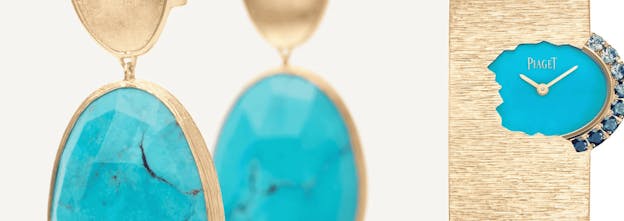Hard Stones in Watchmaking and Jewelry Design
Hard stones, or ornamental stones, have adorned more watch dials than ever. Using onyx, malachite, turquoise, or lapis—the four favorites—watchmakers have embraced their natural beauty. Other examples such as opals, mother-of-pearl, meteorite, labradorite, and aventurine are also among the hard gemstones used by both watch brands and jewelry designers.
The Growing Appeal of Ornamental Stones in Watches and Jewelry
Ornamental stones, also referred to as hard stones, have long been admired for their natural beauty and durability, but recently they have taken center stage in the world of luxury watchmaking and jewelry design. These stones include a variety of materials like onyx, malachite, turquoise, and lapis lazuli, which are among the favorites. There are also unique examples like opals, mother-of-pearl, meteorite, labradorite, and aventurine, which designers have embraced to create visually striking pieces.
Ornamental stones refer to naturally occurring minerals used for decorative purposes, valued for their vibrant colors, textures, and patterns. Hard stones are resilient and typically polished rather than faceted, enhancing their natural sheen. They are not categorized as precious gems like diamonds or sapphires but are instead prized for their aesthetic qualities and origins.
Onyx, for example, is known for its deep, glossy black surface, often seen in dials like the Piaget Altiplano, where it gives a minimalist yet bold appearance. Malachite, with its rich green hues and swirling patterns, has been used in watches like the Cartier Panthère, where its natural bands of color add depth and complexity. Turquoise, prized for its vibrant blue, has adorned watches such as the Rolex Day-Date. Lapis lazuli, with its celestial blue and occasional flecks of gold, can be seen in the Jaeger-LeCoultre Reverso, where its royal hue brings distinction.

In recent years, the trend of incorporating these stones into watch dials has risen exponentially. No two stones are the same, meaning every dial made from a hard stone is a one-of-a-kind creation. This individuality resonates with collectors who seek exclusivity and craftsmanship. Beyond watches, high jewelry designers like Bulgari and Van Cleef & Arpels have long incorporated ornamental stones into their collections. Bulgari’s Diva’s Dream collection, for example, uses malachite and turquoise extensively, showcasing how versatile these materials are across both watches and jewelry.

What makes the use of hard stones so special is their originality and connection to nature. Each stone has its own history, created over millions of years, making every piece a natural work of art. Cutting, polishing, and setting such delicate materials requires immense skill. Many stones, while beautiful, are fragile or prone to cracking if not handled carefully. This elevates their value, as the craftsmanship behind each piece is a reflection of true mastery.
Moreover, the rise of this trend ties to growing appreciation for natural materials and sustainability in luxury. As customers become more environmentally conscious, the use of stones with organic origins creates an emotional connection to the earth. Brands like Rolex, known for its use of mother-of-pearl, exemplify how this trend has influenced even the most established names in watchmaking.
In summary, the rise of ornamental stones in watchmaking and jewelry reflects a shift toward uniqueness, craftsmanship, and a deeper appreciation for nature’s artistry. Whether it’s the deep black of onyx, the celestial blue of lapis lazuli, or the vibrant green of malachite, these stones bring a new dimension to luxury design, offering both visual appeal and a story of natural wonder.

